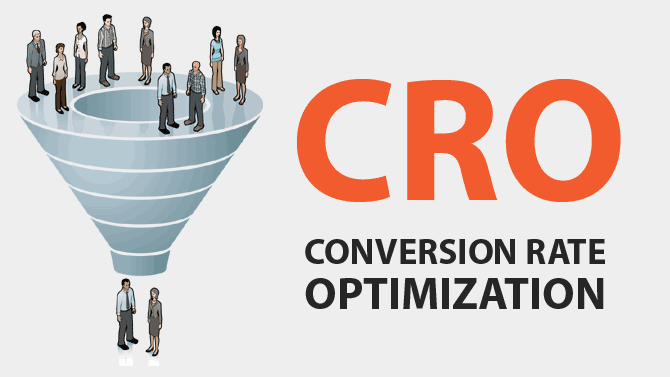WHAT IS CRO? (CONVERSION RATE OPTIMISATION)
In internet marketing, conversion optimization, or conversion rate optimization (CRO) is a system for increasing the percentage of visitors to a website that convert into customers, or more generally, take any desired action on a webpage.
Let’s start by defining conversion…
What we mean when we talk about conversion is when a visitor to your website takes an action that you want them to take.
But what does that look like to you? It could be signing up for an email newsletter, creating an account with a login and password, making a purchase, downloading your app, or something else entirely.
Whatever it is you want your visitors to do, this action is what you are going to measure and what you are looking to optimize.

Conversion Rate Optimisation Is…
- A structured and systematic approach to improving the performance of your website
- Informed by insights—specifically, analytics and user feedback
- Defined by your website’s unique objectives and needs (KPIs)
- Taking the traffic you already have and making the most of it
Conversion Rate Optimisation Is Not…
- Based on guesses, hunches, or what everyone else is doing
- Driven by the highest paid person’s opinion
- About getting as many users as possible, regardless of quality or engagement
A Few Key Terms…
These are concepts and ideas that will come up again and again in this guide, so now is the time to familiarize yourself with them.
Call to Action (CTA)
The primary button, link or other user interface element that asks the user to take an action that leads to (or towards) a conversion. A “Buy Now” button on Amazon.com, a “Sign Up” button on an email registration field, a “Download Now” on an app landing page are examples of different Calls to Action.
Conversion Funnel
The primary pathway (or flow) of the user experience where visitors complete a conversion. On Amazon.com the funnel may be Home page > search results page > product page > checkout.
A/B or Split Testing
The testing of one version of a page or interface element against another version of the same thing. Each element is measured by its effectiveness in comparison to the other. For example, a red button measured in effectiveness to a green button. In A/B testing only one thing is tested at a time.
Multivariate Testing (MVT)
The testing of multiple variations of many different page elements in various combinations to determine the best performing elements and combinations. For example, a multivariate landing test may test many variations of the pictures, copy, and calls to action used on the page in many combinations to find the best performer.
Now About Those Statistics…
Here’s an overview of the things you are going to measure in order to gauge your current rate of conversion, identify the trouble spots, and design a plan of action. You can get these numbers through Google Analytics, KISSmetrics, or another analytics service of your choosing. The numbers critical to CRO are as follows:
Let’s start with the numbers we’re looking to improve—Conversion Rates
- Your Total Conversions is number of people who did whatever it is defined as converting (email newsletter, made a purchase, and so on).
- To get your Conversion Rate, you divide the above total number of conversions by the number of visitors to your site.
For example, a site with 5000 visitors and 50 conversions has a conversion rate of 1%.
But how long are people spending on your site? Which pages are they visiting while there? This next set of numbers can help you to form some testable hypotheses. Looking at your Bounce and Exit Rates, as well as your Engagement Metrics, is the first step in making sense of your conversion rate.
3. Bounce Rate
Your Bounce Rate is the percentage of people who leave after viewing a single page. A high bounce rate is not a good thing–for whatever reason, people aren’t finding what they’re looking for so they leave almost immediately.
4. Exit Rate
You also have a specific Exit Rate for each page; it’s the percentage of people who leave after viewing the page. Your exit rate lets you know the last page that users view before they move on. A very high exit rate on a specific page can be a red flag.
5. Average Time on Site
An Engagement Metric, the Average Time on Siteof users gives you a general idea how long people are sticking around. A high bounce rate means a low average time on site—visitors aren’t sticking around long enough to do whatever it is you want them to do.
6. Average Page Views
Similarly, Average Page Views is an Engagement Metric that tells you how many pages the average visitor through before leaving. More page views can mean engagement but also can mean a lack of clarity in your conversion funnel, if there is no conversion.
These are the metrics that matter. Take the example above—the site with 5,000 visitors per month but only 50 conversions could either pat themselves on the back for all those unique visitors or recognize that their conversion rate could be much better than 1% and then work to optimize those numbers.
If you are wanting more from your website marketing, then talk to us today.


Here is another sample comment in order to test the form. You can edit or remove comments if you are administrator.
Here is a sample reply to a comment…